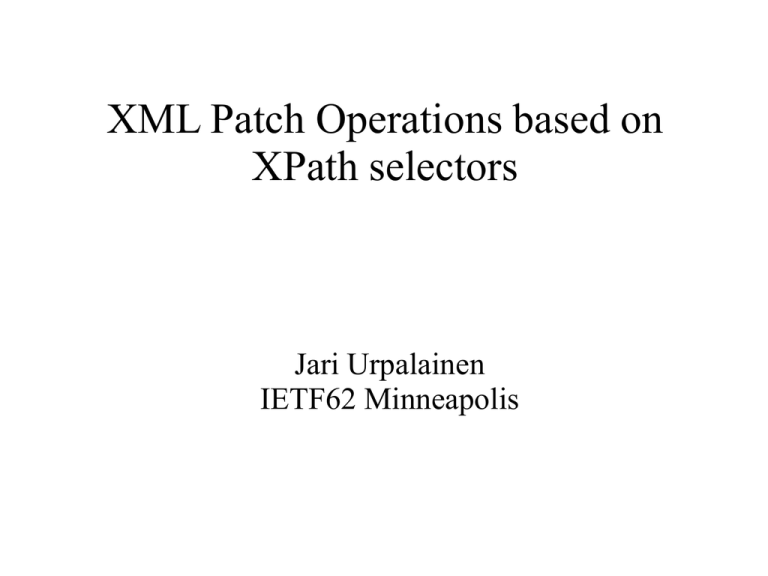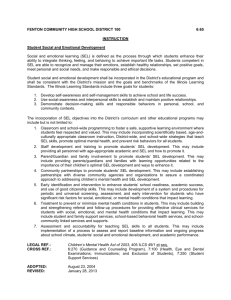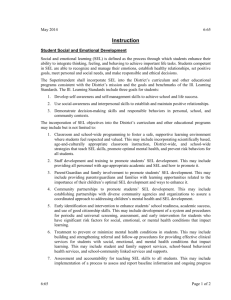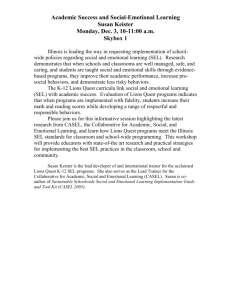PPT Version
advertisement

XML Patch Operations based on
XPath selectors
Jari Urpalainen
IETF62 Minneapolis
Short overview
Purpose was to remove the overlapping parts of xcapdiff and partial-pidf which reference patch-ops
● ~XCAP PUT and DELETE semantics. Patch operations
are embedded within a transported XML document
● Uses XPath 1.0 compatible selectors
● Combines several requests: <add>, <replace> and
<remove> with optional data onto a single XML doc
● XML Schema defines only types without any
targetNamespace -> the elements inherit the namespace
of the including Schema
●
Changes
●
●
●
The names in location steps are fully namespace
qualified.
The framing document (xcap-diff, pidf-diff etc.)
carries all the namespace definitions that are
needed to apply the patch requests
The added or modified data content is also fully
namespace qualified.
Open Issues/BUGS
●
●
●
Whitespace text node handling in <add> and
<remove>
In addition to above lack of XPath data model
nodes: namespaces, comments and processing
instructions
Lack of the ability to say: I want to add these
nodes immediately before/after this element that
already exist within the patched document
Adding namespace definitions
●
namespace axis of XPath 1.0 does the trick
<add sel="root" type="namespace::prefix">urn:xml:ns:something</add>
●
value of “sel” selects the element where the
namespace definition will be added (similar to
adding an attribute with “@”)
<remove sel="root/namespace::prefix"/>
<replace sel="root/namespace::prefix">urn:xml:ns:something</replace>
●
value of “sel” selects the namespace node
<add>
●
except attribute and namespace nodes this will
always (by default) append elements, text nodes,
comments and processing instructions as the last
child(ren)
<add sel="root">
<!-- This is a comment -->
<new-element a=”1”/><new-element a=”2”/></add>
●
This allows an easy handling of whitespace text
nodes as well as several siblings at the same time
<add> parameters
the value of 'sel' attribute selects a single unique
element from the patched doc
● 'pos' attribute: “to” [default], “before”, “after”
● “before” = immediate preceding sibling node
● “after” = immediate following sibling node
● “to” = last child(ren) node or
attribute/namespace
● 'type' attribute; values: node() [default], text(),
@attr, namespace::prefix
● child element(s) or text content of <add> = the
new/updated XML fragment(s) or values for ns/attr
●
Add before and after
●
XPath 1.0 defines axises: preceding-sibling and
following-sibling which could be used:
<add sel="root/elem[@a='1']" type="precedingsibling::node()[1][self::comment()]">This is a comment</add>
●
instead a much simpler model using “pos” attribute
can be used:
<add sel="root/elem[@a='1']" pos=”before"><!-- This is a comment --></add>
<add sel="root/elem[@a='1']" pos=”after">
<!-- This is a new added node --><new-node a=”1”>
</add>
<replace>
●
●
Only one “sel” selector (must locate a unique node)
Last location step includes comment(), processinginstruction(“x”) and text().
<replace sel="root/elem[@a='1']"><update/></replace>
<replace sel="root/@a">new attr value</replace>
<replace sel="root/namespace::prefix">urn:new</replace>
<replace sel="root/comment()[1]">This is a new comment</replace>
<replace sel="root/processing-instruction('foo')">bar="foobar"</replace>
<replace sel="root/elem[1]/text()[1]">This is the new text content</replace>
<remove>
●
whitespace text nodes somewhat problematic
A.<remove sel="root/text()[1]"/>
<remove sel="root/elem[@a='1']"/>
B.<remove sel="root/text()[1] | root/elem[@a='1']"/>
C.<remove sel="root/elem[@a='1']/precedingsibling::text()[1] | root/elem[@a='1']"/>
The proposed model (similar to C, but simpler):
●
in addition to 'sel' an optional whitespace attribute
'ws': "before", "after", "both", "none" [default]
<remove sel="root/elem[@a='1']" ws="before"/>
<?xml version="1.0" encoding="UTF-8"?>
<!DOCTYPE document [
<!ENTITY ncname "[^:\I][^:\C]*">
<!ENTITY qname
"(&ncname;:)?&ncname;">
<!ENTITY aname
"@&qname;">
<!ENTITY pos_t
"\[\d+\]">
<!ENTITY attr_t "\[&aname;=('|&quot;)[.\n]*('|&quot;)\]">
<!ENTITY name_t "\[(&qname;|\.)=('|&quot;)[.\n]*('|&quot;)\]">
<!ENTITY cond
"(&attr_t;|&name_t;)?(&pos_t;)?|(&pos_t;)?(&attr_t;|&name_t;)?">
<!ENTITY step
"(&qname;|\*)(&cond;)?">
<!ENTITY pi
"processinginstruction\((('|&quot;)&qname;('|&quot;))?\)">
<!ENTITY comm
"comment\(\)">
<!ENTITY text
"text\(\)">
<!ENTITY nspace "namespace::&ncname;">
<!ENTITY last
"&step;|&aname;|&nspace;|(&comm;(&pos_t;)?)|&text;(&pos_t;)?|&pi;(&po
s_t;)?">
]>
<xsd:schema ...
<xsd:simpleType name="xpath">
<xsd:restriction base="xsd:string">
<xsd:pattern value="(&step;/)*(&last;)"/>
</xsd:restriction>
</xsd:simpleType>
</xsd:schema>
Impact on xcap-diff & pidf-diff etc.
Common model for applying XML changes
● XML Schemas include patch-ops which is only a
framework for patch operations
● Content-Types are defined according to the
including schema within xcap-diff and pidf-diff
etc.
● As these operations describe the model to patch
the full XPath 1.0 data model node types,
applications may either extend or restrict these as
desired
●







